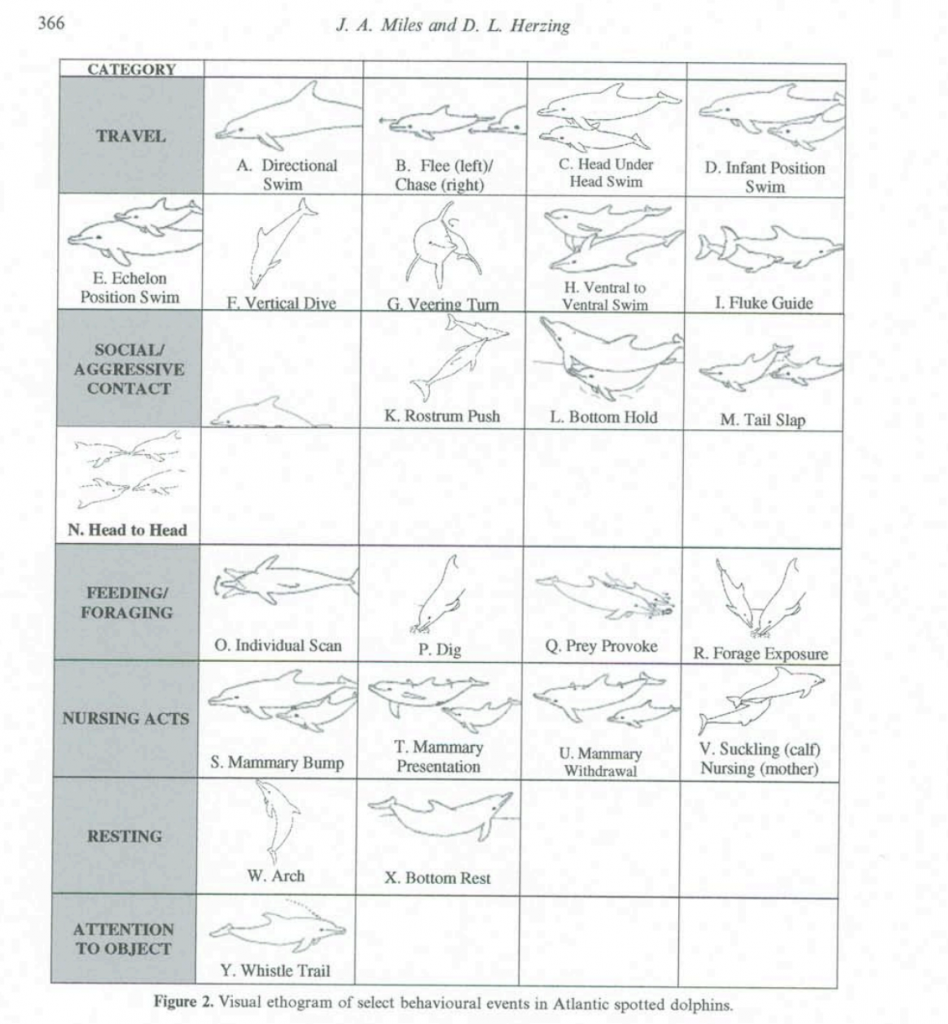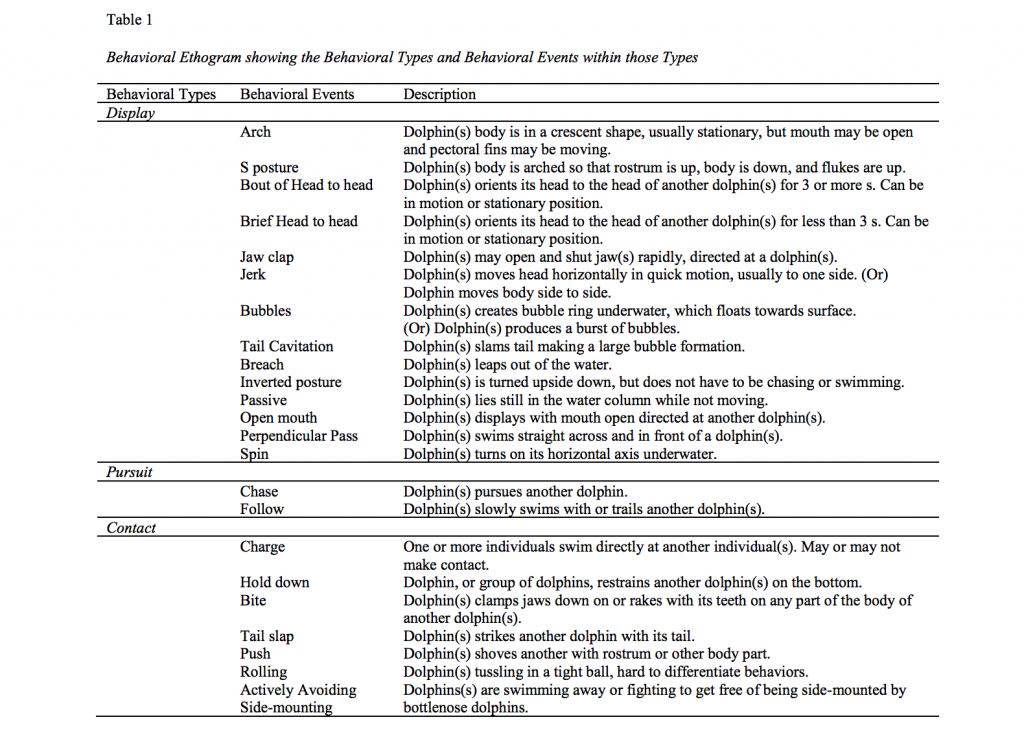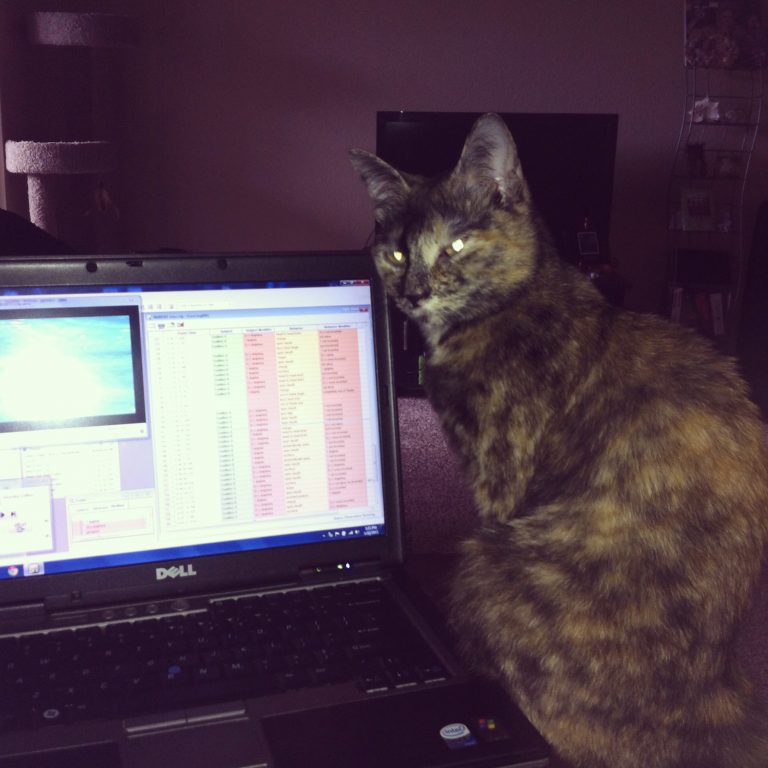At the Wild Dolphin Project, we’ve studied everything from dolphin communication, to social structure, genetics and ecology. One of the most common fields we cover is animal behavior, to examine topics such as interspecies aggression, feeding, and even teaching. In addition to gaining insight into the behavior of a species, understanding animal behavior has broader implications for conservation and management.
To study animal behavior, we need to use an ethogram, which is a list or catalog of an animal’s behaviors. It’s one of the most important tools when studying behavior.
Here’s an example of an ethogram from a study by Miles, J, and D.L. Herzing (2003), called “Underwater analysis of the behavioral development of free-ranging Atlantic spotted dolphin (Stenella frontalis) calves (birth to 4 years of age)” published in the journal Aquatic Mammals. Download This Article

Extraordinary Ethograms
Using an ethogram is important for a scientific study because it creates a standardized list of behaviors that can then be examined and analyzed.
Below is an example of an ethogram in a research study led by WDP biologist Cassie Volker-Rusche for her project examining aggression between the spotted dolphins and bottlenose dolphins. For this study, Cassie’s goal was to determine if male Atlantic spotted dolphins used different aggressive behaviors when they fought those of their own species versus when they fought male bottlenose dolphins.
For this study, Cassie used archival underwater video encounters from the Wild Dolphin Project’s long-term database. Twenty-two videos were extracted and analyzed, totaling more than 180 minutes. When watching the video, Cassie would indicate in the Observer program when she saw one of these behaviors occur, which allowed her to later analyze the frequency of those behaviors and whether or not there were statistically significant differences.
“Aggression is behaviorally rich, meaning there is a lot of activity happening all at once. With so much going on, it can be hard to figure out what you are looking for. The Ethogram I used for this study was developed from behaviors Dr. Herzing had already identified as being aggressive. Once I had that list of behaviors to look for, I was able to decipher more of what was happening,” said Cassie.
For example, she said “if you don’t understand a sport you are watching it can be hard to follow and hard to see details such as specific plays. It’s the same when watching a group of animals behave when you have no idea what they are doing. But having an ethogram, which is almost like a play book, you can see the specific behaviors and more easily follow what’s going on.”


A bottlenose displaying an S-posture, something on WDP biologist Cassie Volker-Rusche’s ethogram for her behavioral study on aggression.
Check out a video clip on our Youtube channel here, showing an aggressive clip with labeling of different behaviors.
From her study, she was able to conclude that when the slender spotted dolphins fought the larger bottlenose dolphins, they more often used behaviors that required more energy, such as chasing. But when the spotteds fought each other, they used display behaviors like open-mouths, rather than biting or chasing.
Data Collection
When we find a dolphin group in the Bahamas, our primary data collection includes categorizing the broadest behavioral state of the majority of the group: aggression, foraging, traveling, socializing or resting. We also collect data on the habitat, environmental conditions, and the individuals in the group. When we enter the water we document what’s going on using video cameras, still cameras, as well as hydrophones to collect underwater vocalizations. Every encounter gets a number, with the corresponding data sheet, video footage, photos and acoustic data.
Once the video footage is downloaded and data sheets are entered digitally, our scientists can use those broad categories to search the database to find specific encounters that might be helpful based on the question being asked. So for Cassie, she first had to search aggressive encounters, and ones that were either just spotteds as well as spotteds and bottlenose. After spending hours searching through videos, she picked 22 videos to analyze in greater detail, using her ethogram.
The process of behaviorally coding these videos “was very tedious and time-consuming, often requiring going through each video multiple times,” Cassie said. During these long hours, her two cats Luna and Suri, were often snuggled up on her lap during the process.

Cassie has some feline company while watching dolphin videos and coding behaviors on her ethogram.
Ethograms help scientists understand more about animal behavior and draw conclusions from those behaviors, whether it’s understanding the kinds of behaviors males might use when fighting and why, or where a calf hangs out in relation to a mother when she is feeding.
“Ethograms are the backbones of behavioral studies, and are basically your rubric. They list out, in black and white, the behaviors you analyzed and allow other scientists to replicate your study looking for the exact same behaviors you looked for,” said Cassie.
“It’s also easy to get distracted or zone out when observing a lot of behaviors at once. But your Ethogram can keep you focused and remind you what you are looking for when you are analyzing your data.”
Read more:
Read a blog about Cassie’s aggression study here.
